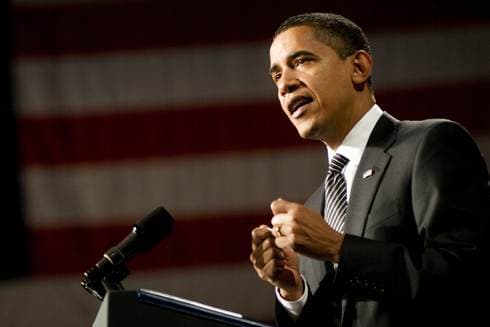- 45% of homeowners with mortgage have 80%+ LTVs.
- A mass refinance would put an average of $355 into homeowner's pockets.
- The program's goal is that costs would be offset by an economic stimulus.
President Obama Pledges to Send Mass Refinance Plan to Congress.
Update: President Obama discussed mass refinancing in his Jan. 24, 2012 state of the union address. We added his remarks below. See the Bills.com Obama Refinance Plan page for information on information the President announced on February 1, 2012.
The following are quotes from President Obama’s Jan. 24, 2012 state of the union address, which mention mass refinancing:
"While government can’t fix the problem on its own, responsible homeowners shouldn’t have to sit and wait for the housing market to hit bottom to get some relief. That’s why I’m sending this Congress a plan that gives every responsible homeowner the chance to save about $3,000 a year on their mortgage, by refinancing at historically low interest rates. No more red tape. No more runaround from the banks. A small fee on the largest financial institutions will ensure that it won’t add to the deficit, and will give banks that were rescued by taxpayers a chance to repay a deficit of trust."
Obama blamed both lenders and some borrowers for the current housing situation.
"We’ve all paid the price for lenders who sold mortgages to people who couldn’t afford them, and buyers who knew they couldn’t afford them. It’s time to apply the same rules from top to bottom: No bailouts, no handouts, and no copouts. An America built to last insists on responsibility from everybody."
The Argument For Mass Refinancing
"Terrible" is the best word to describe the housing markets in Arizona, California, Florida, Georgia, Michigan, and Nevada, at the start of 2012. The percentage of upside-down homeowners in those six states ranges from 35% to 65% of all homes. The numbers for the rest of the US are not as bad, but only by comparison.
The number of bank-owned properties is high across the US, as well as the number of properties offered for sale as short sales. For the last two years, bank-owned properties (called REOs) and short sales made up 40-45% of all home purchase transactions. Those numbers will not go down anytime soon. RealtyTrac reports that the owners of 1.8 million properties received repossession notices in 2011, and 804,423 were repossessed last year. (See chart below for more details.)
Approximately 10.7 million, or 22% of all residential properties with a mortgage are upside down, according to CoreLogic, a data provider to lenders. Among upside-down homeowners with conventional loans, the average mortgage balance is $272,000, and are underwater an average of $70,000. Upside-down FHA borrowers have an average balance of $170,000 and are underwater $26,000.
As bad as the numbers are for upside-down loans, the numbers for 80%+ loan-to-value (LTV) loans are worse. About 22 million, or 45% of all homeowners with a loan, have an 80%+ LTV. 69% of these 80%+ LTV loans have interest rates of 5% or more.
These numbers are behind an agonizing situation for homeowners. Those who want to refinance to today’s historic low rates cannot because their LTV is too high. Homeowners who need to sell compete against REOs and short sales, which drag market prices downward. Mass refinancing to sub-4% loans would put more money in homeowner’s pockets, which would stimulate the economy. Lower loan payments would potentially cut the foreclosure and short sale rate because more homeowners could afford to remain in their homes.
Beyond HARP 2.0
In November 2011, President Obama announced changes to the Home Affordable Refinance Program. Called "HARP 2.0" informally, the changes to HARP will qualify another 5 million homeowners for a refinance. As large as this number sounds, it does not help all 10.7 million upside-down homeowners, nor does HARP 2.0 address people with delinquencies or the age of their mortgages, which disqualify many from HARP. (More after the following graphic.)
Analyst Jaret Seiberg of the Washington Research Group, a financial research firm, kicked off a storm of discussion in early January when he released a report implying that President Obama will replace the FHFA’s acting director, Edward DeMarco, with a consumer-friendly "housing advocate." A mass refinance would follow, and impact every Fannie Mae and Freddie Mac loan in their portfolios. One estimate is that $3.7 trillion of mortgages would be refinanced, and brought to 4% or less.
The result of a mass refinance would be the average homeowner seeing their mortgage payments fall by an average of $355 per month. The cost would be $242 billion, which would be split between lenders (investors in mortgages) and the federal government.
On the other hand, the macro-economic effects on consumer spending and tax revenue would be immediate and off-set part of the cost of the program. According to Glenn Hubbard, dean of Columbia Business School and former chairman of the Council of Economic Advisers under President Bush, U.S. consumption would rise by $63 billion relative to what would otherwise have occurred. Overall, the total macroeconomic stimulus would be as much as $118 billion per year, according to Hubbard.
White House Reaction to Mass Refinance
The White House reacted to Seiberg’s report by telling a Bloomberg news reporter that it has no plans for a mass mortgage refinancing program in early January. (Editor’s note: Obama’s state of the union address, as we saw above, did mention mass refinance.) However, James Pethokoukis, a blogger at the American Enterprise Institute, said that Ben Bernanke, chairman of Federal Reserve, and Bill Dudley, the head of the New York Federal Reserve, have released reports arguing that Fannie and Freddie should expand HARP to beyond 2.0.
Pethokoukis points out that Obama would not need Congressional approval to authorize a mass mortgage refinancing, and that the President may do so in an election-year effort to persuade voters that he is taking action on a thorny issue.
